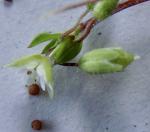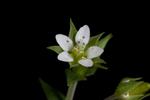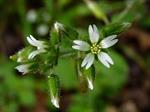Click the number at the start of a key lead to highlight both that lead and its corresponding lead. Click again to show only the two highlighted leads. Click a third time to return to the full key with the selected leads still highlighted.
1 Leaves not accompanied by stipules (stipules absent). |
..2 Sepals fused into a toothed or lobed tube |
..2 Sepals distinct, or slightly fused at their bases |
1 Leaves accompanied by stipules (stipules present), these scarious or hyaline and readily apparent. |
....3 Fruit a utricle; seed 1 per fruit; petals absent. |
......4 Leaves alternate; staminodes petaloid, ovate to oblong; [tribe Corrigioleae] |
......4 Leaves opposite (or the uppermost alternate in Herniaria); staminodes not petaloid, subulate; [tribe Paronychieae]. |
........5 Stipules inconspicuous; sepals green-margined, obtuse, lacking awns |
........5 Stipules usually conspicuous; sepals white-scarious-margined, hooded or awned |
....3 Fruit a capsule; seeds 3-many per fruit; petals present. |
..........6 Floral bracts and sepals scarious throughout (thin and membranous), appearing chaffy; [non-native of disturbed, sandy habitats; c. and w. FL] |
..........6 Floral bracts and sepals not scarious nor appearing chaffy (the margins hyaline, but not scarious throughout); [natives and non-natives, collectively widespread]. |
............ 7 Stem leaves subulate, 1-2 mm long, pectinate-fringed at the base; basal rosette leaves spatulate (usually withering quickly after overwintering; stems wiry, stiff, subdichotomously branched; [of xeric sands on the Coastal Plain from se. VA southward] |
............ 7 Stem leaves larger, mostly both longer and broader, not pectinate-fringed at the base; basal rosette present or absent; stems either thicker, more flexuous, or not subdichotomously branched; [collectively more widespread]. |
............ ..8 Leaves appearing verticillate, 10-16 per node, filiform to linear; [tribe Spergulaeae] |
............ ..8 Leaves opposite or in whorls of 4, linear to ovate or spatulate. |
............ ....9 Leaves mostly in whorls of 4, obovate-spatulate, 2-8 mm long; [tribe Polycarpaeae] |
............ ....9 Leaves opposite, linear or orbicular, 5-40 mm long. |
............ ......10 Leaves orbicular-ovate; styles partly united; [tribe Polycarpaeae] |
............ ......10 Leaves linear; styles separate; [tribe Spergulaeae] |
1 Calyx immediately subtended by 1-3 pairs of bracts; [tribe Caryophylleae]. |
|
|
1 Calyx lacking subtending bracts. |
....3 Sepals 25-62 mm long; calyx lobes longer than the calyx tube, the lobes as long as or longer than the corolla lobes; [tribe Sileneae] |
....3 Sepals (1-) 10-28 (-40) mm long; calyx lobes shorter than the calyx tube, the lobes much shorter than the corolla lobes (except Gypsophila). |
......4 Styles 2; fruit valves 4; petals appendaged or not; [tribe Caryophylleae]. |
........5 Sepals 1-5 mm long, the commissures between the sepals scarious. |
..........6 Leaves lanceolate to ovate, (1-) 2-20 (-35) mm wide; plants few-branched, or if diffusely-branched, only in the upper half of the plant's length |
..........6 Leaves linear, 0.2-2 (-3) mm wide; plants diffusely branched from near the base upwards |
........5 Sepals 7-25 mm long, lacking commissures. |
............ 7 Calyx tubular, 20-nerved; petals appendaged; perennial |
............ 7 Calyx ovoid, 5-nerved; petals not appendaged; annual |
......4 Styles 3-5 (or 0 in staminate plants); fruit valves 3, 4, 5, 6, 8, or 10; petals generally appendaged; [tribe Sileneae] |
............ ..8 Plant glabrous; calyx glabrous, narrowly funnelform, dilated above the midpoint; petals pink; stem with glutinous zones on upper internodes |
............ ..8 Plant glabrous or pubescent; calyx glabrous or pubescent, either tubular (nearly the same diameter through its length) or broadened below the middle (flask-shaped); petals white or pink (rarely absent); stem lacking glutinous zones (except S. antirrhina). |
............ ....9 Styles mostly 3; capsule with 3 or 6 teeth; calyx tubular or campanulate at anthesis, not greatly inflated (except in S. vulgaris) |
............ ....9 Styles mostly 5; capsule with 5 or 10 teeth; calyx tubular at anthesis, becoming strongly inflated later in S. dioica and S. latifolia. |
............ ......10 Petal limbs deeply divided into 4 linear segments; [or, former Lychnis section Uebelinia] |
............ ......10 Petal limbs unlobed, emarginate, or shallowly 2-lobed. |
............ ........11 Leaf blades with dense silky white hairiness; flowers bisexual; [or former Lychnis section Agrostemma] |
............ ........11 Leaf blades variously pubescent, but not with silky-appressed pubescence; [ Silene section Melandrium] |
1 Petals absent; fruit a 1-seeded, indehiscent utricle; styles 2; [tribe Sclerantheae] |
1 Petals present (rarely obsolete or essentially absent); fruit a few-many seeded capsule; styles 3-5. |
..2 Leaves fleshy; seeds > 3 mm long; [of seabeaches and dunes] ; [tribe Sclerantheae] |
..2 Leaves membranaceous or stiff; seeds < 2 mm long; [of various habitats]. |
|
......4 Leaves linear-subulate, < 2 mm wide; styles 4-5. |
........5 Valves or teeth of the capsule twice as many as the styles; [tribe Alsineae] |
........5 Valves or teeth of the capsule as many as the styles; [tribe Sagineae] |
......4 Leaves ovate, obovate, > 4 mm wide; styles 5; [tribe Alsineae]. |
..........6 Capsule cylindric, dehiscent by 10 apical teeth |
..........6 Capsule ovoid, dehiscent by 5 valves, each apically 2-cleft |
|
............ 7 Inflorescence umbelliform; petals irregularly denticulate at apex; [tribe Alsineae] |
............ 7 Inflorescence cymose or racemiform; petals entire, notched, or deeply cleft. |
............ ..8 Petals shallowly to deeply 2-cleft, notched at least 1/4 of the length, often divided nearly to the base and then appearing almost as 10 petals; [tribe Alsineae]. |
............ ....9 Capsule cylindric, twice as long as the sepals; petals 2-cleft 1/5 - 1/2 length; styles (3-) 5 (-6), 0.5-2 mm long |
............ ....9 Capsule spherical, ellipsoid, or globose, as long as or slightly longer than the sepals; petals 2-cleft 2/3-3/4 length (1/2 length in Rabelera); styles (2-) 3 (-5), 0.2-7 mm long |
............ ......10 Stems square; petals 2-cleft ca 1/2 of length |
............ ......10 Stems round or roundish; petals 2-cleft 2/3 to 3/4 of length |
............ ..8 Petals entire, or emarginate. |
............ ........11 Valves or teeth of the capsule as many as the styles. |
............ ..........12 Leaves strongly basally disposed, most in the lowermost 1/3 of the stem, and overlapping (the internodes < the leaf length; leaves firm, with axillary fascicles of leaves; [tribe Sagineae] |
............ ..........12 Leaves evenly distributed along the stem and widely spaced (the internodes > the leaf length); leaves herbaceous to slightly fleshy, generally without axillary fascicles of leaves. |
............ ............ 13 Sepals 4; petals 0; [tribe Sagineae] |
............ ............ 13 Sepals 5; petals 5; [tribe Sclerantheae] |
............ ........11 Valves or teeth of the capsule twice as many as the styles. |
............ ............ ..14 Seeds with an aril; [tribe Arenarieae] |
............ ............ ..14 Seeds lacking an aril. |
............ ............ ....15 Capsule straight; petals entire or barely emarginated; [tribe Arenarieae] |
............ ............ ....15 Capsule cylindrical, and often somewhat curved; petals emarginate to bifid; [tribe Alsineae] |


